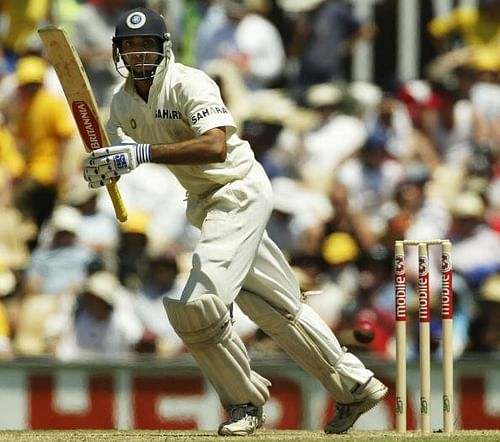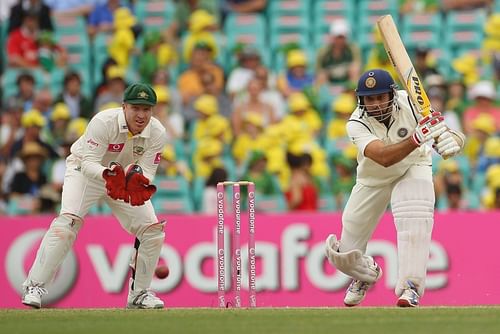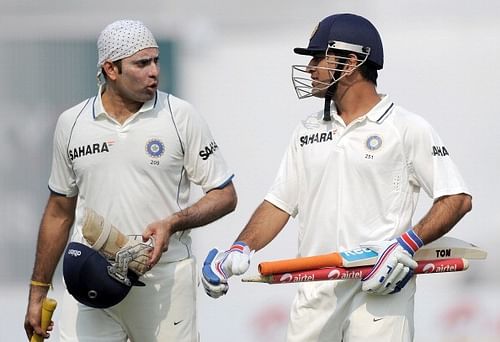
VVS Laxman - What makes him a "Very Very Special" cricketer?
When VVS Laxman stepped into that sun-smothered and humid afternoon at Sydney Cricket ground in 2008 against his favorite rivals, Australia, India was in dire need of a resurgence of emotions and spirit. After being outplayed in the first test, questionable umpiring had left them at 8/1 in reply to Australia’s 463 when he walked in.
It was not his preferred position but he stepped in, with a firmness in his walk, standing erect to the Australian sledge - their primitive weapon of distraction and destruction. Having Dravid on the crease, Laxman began his retribution in his own style and showed the authority on those 22 yards. While “The wall” was struggling to find the gaps in the field and got ironic applause from the crowd when he opened his account, this Very Very Special cricketer from Hyderabad, dominated the Australian pacers and broke the shackles.
The noise of the ball hitting the bat had the signs of conviction, his cover-drives and the exquisite wrist work, a product of his own style, had the unspoken class that sets him apart. For the next few hours, he launched one of the greatest counter-attacks in recent memory and allowed his bat to do the most of the talking.
Every ball that kissed the bill-board on the boundary silenced the enemies and he maneuvered an innings which was to change the course of the game. At times, Mitchell Johnson was bowling with two extra-covers, a short mid-off and a point, but none of them mattered to him. His bat evoked a sweet sound to caress the ball through the gaps for two boundaries followed by another through covers, and then, as if completing the icing on the cake, flicked another one on the on-side- a territory that he dominated with his wily wrists.
For his 109 off 142 balls, he batted as the epitome of elegance – as he had done over the course of his career. The innings was not as colossal as the 281 in Kolkata but had a cascading effect on Indian spirits. Though the touring side lost the match, his innings set the stage and prompted his team-mates to join the revolt, which he began in that match.
In the next test at Perth, a fighting innings of 79 in second innings, with crucial partnerships with MS Dhoni and RP Singh ensured that India won the match by 72 runs and were on the brink of an epic comeback in the series. He did what he had done years’ ago in Kolkata and in Adelaide, infusing the fire in belly of his team-mates to make a loud statement. The revenge had been taken and sledging had been kept aside by a thrilling display of cricket.
That’s how he was- the man with a “very very special” wrists who flicked the oppositions with his deceptive class and grandeur. If the greatness of his other peers is well-spoken and justified, there is a strong need to go into the archives to extract the rare achievements that makes him “Very Very Special”.
So what makes him a “Very Very Special Cricketer”? Let’s see:
His glorious run against Australia:
If test cricket was his favorite battlefield, Australia was the opponent against whom he stood intact with resoluteness and rescued India from the jaws of defeat on several occasions. Australians are a grueling opponent, who will sledge you, test you with their fiery pace and even the crowd will chip in, to add spice to the occasion.
He averaged almost 50 against mighty “Kangaroos”, scoring close to 2500 runs in 29 matches. 6 out of 17 test hundreds have come against them out of which 4 of them are in their own backyard where pace and bounce can get the better of any batsmen.
His batting prowess against Pace bowling:
If he was skilled in handling the finest pace bowlers of his time, it was a mere consequence of his roots being cultivated in Hyderabad, where cricket is mostly played on artificial wickets, due to dearth of proper soil and irrigation facilities. That coupled with his wizardly wrists have displayed their magic on various occasions, much to the astonishment of opposition bowlers.
He scored more than 4000 runs in test cricket against Pace bowlers which justifies his batting prowess against pace bowling. Though his batting lacked the spice of Hyderabadi Biryani, it had all the components of the traditional beauty that the city is blessed with. It brought tranquility, calmness and with that, added another flavor into the Indian batting line-up.
His ability to stitch partnerships with the middle-order and tail:
For majority of his career, the position in which he batted, was an ominous one, because of the imminent danger of the new ball and the distinct possibility of running short of partners. The fort that he guarded, always had the danger of being demolished anytime, because his comrades were not as good as he was in batting. But, Laxman was very good in playing along with them and stitching crucial partnerships during moments that mattered the most. While his best on-field partner was Rahul Dravid, he has 90 fifty-plus stands and 43 hundred-plus stands to his name which depicts that his contribution to Indian cricket was prolific.
His counter attack never had the gunfire of a Sehwag or Sachin, but he did so with a paint brush - painting the canvas with a marvelous picture which looks inscrutable to most but comes out as a piece of high significance. With the experience of playing at no. 5 and 6, he adopted himself to the caveats of that position and developed a rare habit of handling the tail and scoring the runs. If we dwell deep into his statistics, 5000 runs in his test career have come from batting at those dreadful positions and 11 out of his 17 test hundreds have been scored while batting on these positions.
Formidable defence:
Laxman‘s prodigious talent was his ability to save Test matches for his side. If you look at any great team, they can have the best attacking batsmen but it is the defense which comes to the rescue in situations where batsmen are challenged either by bowlers or by surface.
He averages over 55 in winning cause and more importantly, close to 63 in drawn results which is enough to exhibit the importance of his role in the side. If this does not indicates his fortitude, he averages close to 55 and 41 respectively in third and fourth innings of a test match, which makes him the legend in his own right.
Years ago, he called it a day without any fanfare and with that retired all the “very very special” moments that he produced with his majestic class and aplomb. If there is one void which will be hard to fill is the one that he left because since he has left the field, India has struggled to find a permanent replacement for the position on which he batted.
He was one of the greatest players not because of the amount of runs that he scored, but because of the challenges he endured while batting where he did.


